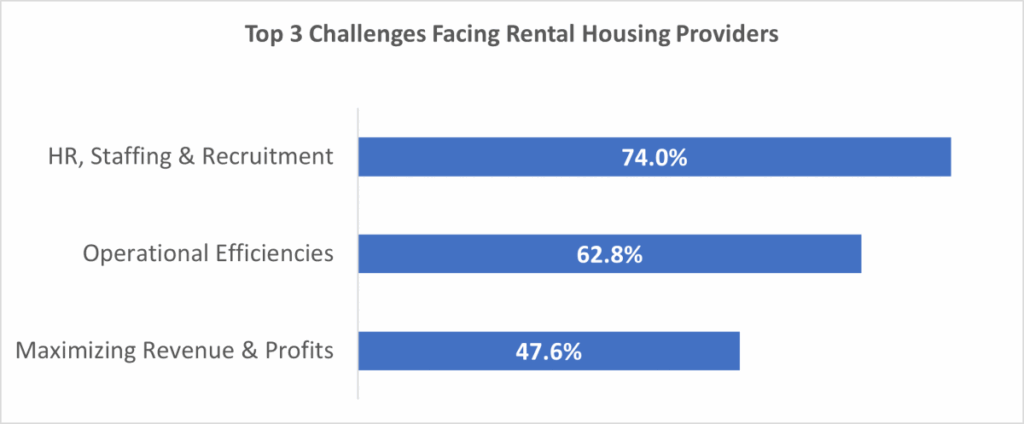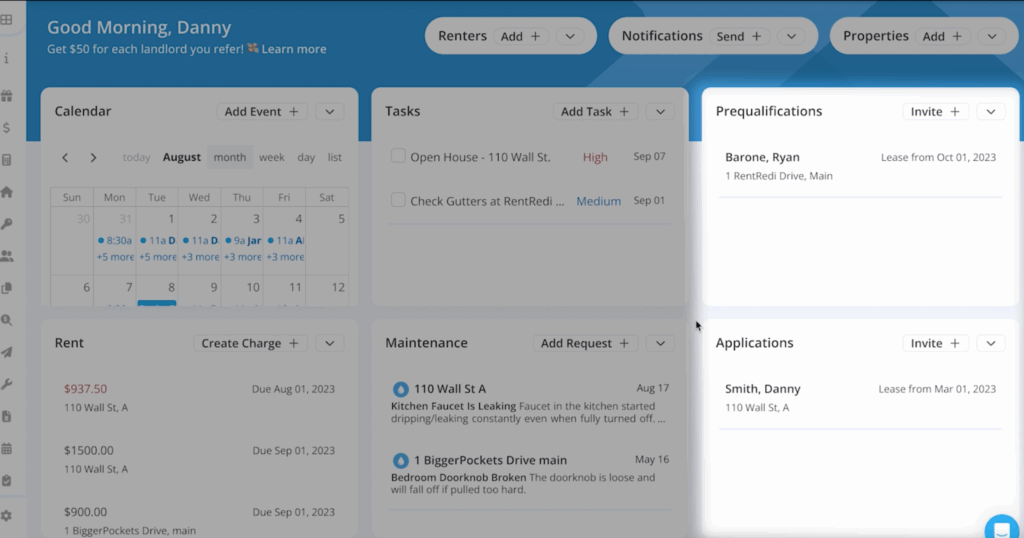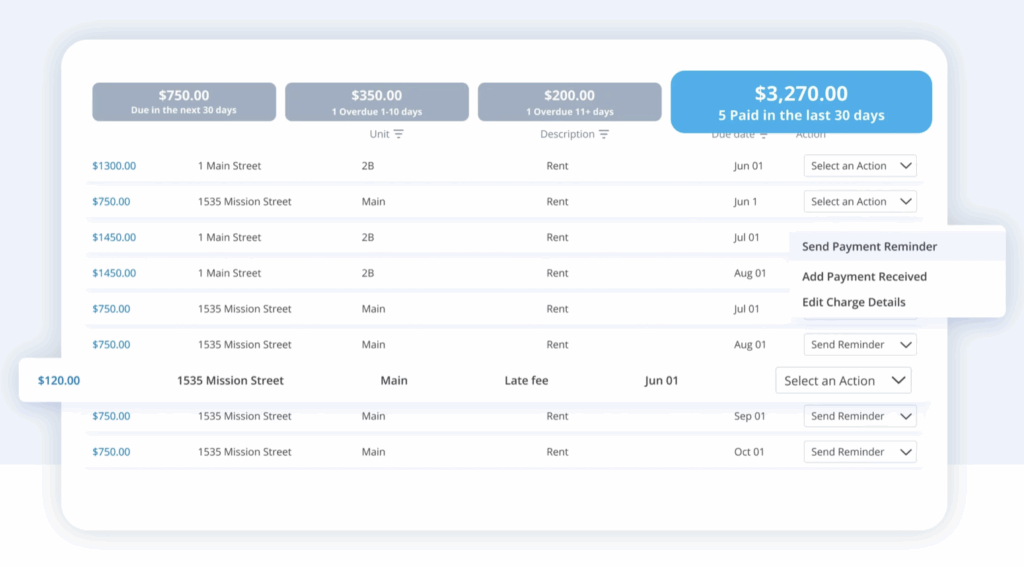Centralized Property Management Dashboards: Simplify Managing Multiple Properties
Simplify property management. Discover how a centralized dashboard streamlines tasks, boosts efficiency, and helps landlords manage multiple properties.
Did you know that property managers take care of multiple properties? Three-quarters of them (75%) manage eleven to 500 units; Half (50%) handle 100 units or less; and 15% deal with over 500 units. How do they stay on top of all these properties and rub elbows with their respective renters?
Unfortunately, property managers and even landlords managing multiple units face several challenges. Think of scattered pieces of tenant information, a pile of lease paperwork, tons of maintenance requests, and due rental payments waiting to be collected. That’s where a centralized property management dashboard can help!
On this page, we’ll cover the use of a centralized dashboard for property management, including its key benefits. As a landlord or property manager, learn how to set up a unified platform to rise above the challenges of managing multiple properties. Read below.
Challenges of Managing Multiple Rental Properties
It’s no secret in the real estate industry: The rental business is booming. However, property management is no easy feat for landlords and property managers. In fact, their top three challenges generally include HR, staffing, and recruitment (74%), operational efficiencies (nearly 63%), and maximizing revenue and profitability (over 47%).

But as a landlord or property manager, what if you’re managing multiple properties? You could face the challenge of maintaining two things: the properties themselves and your tenant relationships. However, there’s more to these than you might think.
That said, here are the top challenges of managing multiple properties you should rise above:
- Scattered information: Tenant records, lease agreements, and payment histories often get tucked away in different places. Without a central hub, tracking details can feel like searching for a needle in a haystack.
- Time-consuming tasks: From collecting rent to processing maintenance requests, repetitive admin tasks eat up hours. What should be simple becomes a grind that slows down your operations.
- Communication gaps: Misunderstandings with tenants, staff, or vendors are common when you’re juggling multiple properties. Delays and missed messages can quickly sour relationships.
- Overlooked maintenance: With numerous units to track, it’s easy to overlook minor repairs that can later snowball into costly fixes. Staying ahead of upkeep is a constant balancing act.
- Mismanaged finances: Managing income and expenses across multiple properties can become complicated quickly. Without accurate oversight, profitability slips through the cracks.
“When choosing a property management platform, focus on tools that simplify your daily workflow. Make sure your team can easily navigate the dashboard and access the information they need. Automation should reduce repetitive tasks, not create more work. A centralized system helps managers stay organized and improve tenant satisfaction”, says Holly Finnefrock, Founder and CEO at Everblue Pond.
Given all these challenges, what better way to optimize your rental business than to implement a property management system? That’s where a centralized dashboard comes into the real estate scene.
Discover the practical applications of centralized dashboards for property management below.
Benefits of Centralized Property Management Dashboards
Property management encompasses several key tasks, including property listings, tenant screening, property maintenance, tenant communication, and rent payment collection. Likewise, consider the lease contracts, tenant information, maintenance logs, and financial reports you need to keep and save. It’s a good idea to tackle these tasks and details, all in one place!
Enter the centralized dashboard for property management. Take RentRedi’s property management software, for instance.
This platform offers various features, including tenant communication, integrated maintenance, rent collection, and a mobile app, among others. Refer to the image below to see how the platform enables you to schedule events, screen tenants, collect payments, and confirm maintenance requests.

A centralized dashboard for property management offers several benefits that can help you improve your operations and scale successfully. Here’s why you should consider investing in a centralized property management dashboard managing multiple properties and tenants:
- Single source of truth: With a centralized dashboard in place, there are no more scattered records. All property data, tenant details, and financials live in one secure place, making oversight much simpler and easier.
- A boost in efficiency: A unified platform automates repetitive tasks and streamlines workflows for managing multiple properties. Ultimately, a rental property management software saves time and money for landlords.
- Better tenant experience: With faster communication and smoother processes, tenants get platinum-level tenant support. This builds trust and encourages long-term leasing.
- Proactive maintenance: A centralized dashboard could flag upcoming inspections, track work orders, and even send alerts. That way, you can stay ahead of costly issues before they spiral.
- Financial profitability: All-in-one property management software is capable of consolidating income, expenses, and ROI insights. As a landlord or property manager, you gain financial clarity, allowing you to make profit-driven decisions.
Learn how to set up and utilize a unified platform for property management in the next section.
How to Set Up a Centralized Property Management Dashboard
It’s time to digitize your rental business with property management software. And what better way to optimize your workflow than to leverage a centralized dashboard? It’s best to manage your property listings, tenant details, lease contracts, maintenance requests, and payment collections, all in one place.
How do you go about doing that? Here’s how to get started using a centralized property management dashboard:
1. Check your needs
Before investing in a centralized platform, examine your current property management processes first. As a landlord or property manager, what areas are you struggling with: real estate marketing, renter screening, tenant communication, or rent collection? Here are aspects of property management you need to assess first:
- Property listings: Are your units reaching the right renters? Scattered and outdated listings can cause vacancies to linger longer than necessary.
- Lease paperwork: Paper trails pile up fast. Without digital contracts, you risk losing documents and missing signatures with unnecessary back-and-forth.
- Tenant communication: Fragmented conversations, from emails to phone calls, can lead to missed updates and strained tenant relationships.
- Maintenance reporting: If requests come through texts and calls, it’s easy for minor issues to slip through the cracks, becoming bigger headaches later on.
- Financial recording: Juggling spreadsheets with receipts across multiple properties often results in errors and delays, thereby overlooking cash flow trends.
Let’s say, for example, your property management workflow goes as smoothly as possible. However, there’s one thing you struggle to streamline: Welcoming new tenants to set a good first impression. In that case, you can simplify tenant onboarding with e-signatures and virtual ID verification. More importantly, meet them with a warm welcome as a property manager.
2. Pick the right platform
The good news: They are integrated with modern technologies, such as robotic process automation (RPA) and artificial intelligence (AI). However, while your centralized dashboard options are endless, you need to choose one that is best suited for your property management type. That said, here’s what to consider:
- Ease of use: A platform should be simple enough for both landlords and tenants to navigate. If it feels overly complicated, adoption will be slow and frustrating.
- Mobile accessibility: Tenants value convenience, so choose a solution with strong mobile support. RentRedi’s mobile app for tenants, for example, makes it easy for them to pay rent, submit maintenance requests, and stay connected.
- Technological integration: Make sure the platform connects seamlessly with your existing tools, such as accounting systems, payment processors, and CRMs, to avoid redundant work.
- Privacy and security: Protecting sensitive tenant data and financial records is non-negotiable. Look for platforms with encryption, secure logins, and regular updates.
- Ensured scalability: As your portfolio grows, your software should grow with you. A scalable dashboard prevents the need to switch systems down the road.
Leon Huang, CEO at RapidDirect, recommends performing due diligence when choosing a centralized dashboard for property management. Their company also carefully selects digital tools and platforms when investing in modern technologies.
Huang says, “When selecting a centralized dashboard, it’s crucial to perform due diligence and ensure the platform aligns with your business needs and long-term goals. We take the same approach by carefully evaluating digital tools before investing in them to guarantee efficiency and scalability.”
3. Centralize data
After investing in a centralized dashboard, it’s time to gather all pertinent information for property management. You should sync your individual tools with your current unified system and import all needed data. Even manual paperwork needs to be turned into a digital format for record purposes. Here’s what to keep:
- Property details: Keep a clear record of addresses, unit numbers, and property features to make oversight effortless.
- Lease agreements: Store digital copies of signed contracts so they’re always accessible when needed.
- Tenant records: Consolidate applications, background checks, and contact information in one secure place.
- Maintenance logs: Track service requests, vendor details, and completion dates to stay ahead of upkeep.
- Financial data: Centralize rent payments, expenses, and reports in a single dashboard to maintain audit readiness and ensure all financial records are accurate and easily accessible.
Learn from Ian Gardner, Director of Sales and Business Development at Sigma Tax Pro. Their company also utilizes a unified platform for managing taxes on behalf of their clients. He highlights the value of a centralized platform, whether for the finance sector or the real estate industry.
Gardner explains, “A centralized platform brings all critical information into one place, which reduces errors and improves efficiency. We’ve seen how this approach streamlines workflows in finance, and the same principle applies to real estate as well. Clarity and accuracy lead to better decisions.”
4. Set up automation
You can scale your rental business best with smart property management by leveraging AI and automation. After importing data, you can now automate various workflows—such as rent and tenant screening. This will enable you to be more efficient and productive in your role as a property manager. Here’s how to set up automation for each workflow:
- Lease termination/renewal: Automate alerts for upcoming lease expirations. That way, you can promptly send renewal offers or prepare listings for new tenants.
- Rental payment reminder: Set up automation for the rent collection process. Use RentRedi’s automated rent collection, for instance, to send reminders and process payments without manual chasing.

- Regular maintenance scheduling: Schedule routine inspections and upkeep tasks automatically. Doing so prevents costly repairs down the line.
- Tenant request confirmation: Tenant request confirmation: Set instant acknowledgments for service requests. For example, if you have your own rental business website, you can set up AI agents that direct your renters immediately to RentRedi’s Support team if they have a question related to their tenant app.
- Community updates: Share announcements, such as policy changes and neighborhood events, through automated messages. This is to keep all tenants informed at once.
Andy Wang, Marketing Manager at Skywork.ai, suggests incorporating AI and automation into your centralized dashboard. Their business achieves the same benefits for their current platform in terms of efficiency and productivity.
Wang shares, “AI-powered automation removes the bottlenecks of repetitive tasks and keeps operations running smoothly. Automation boosts both efficiency and tenant satisfaction, making it a smart move for property managers as well.”
5. Train your team
At this point, it looks like your property management platform is all set up with centralized data and automated tasks. However, the work doesn’t stop here. You need to introduce your team to the new tool and train them on how to use it. This proper orientation and training also extend to all stakeholders involved:
- Landlords: Get familiar with dashboards that track finances and performance. You can make smarter investment decisions at a glance!
- Property managers: Learn how to oversee daily operations, from tenant communication to maintenance tracking, without jumping between tools. That’s your day-to-day work as a property manager!
- Staff: Train your on-site teams to log tasks, updates, and inspections directly into the platform for seamless coordination. A centralized dashboard makes their lives much easier and their work faster!
- Vendors: Provide access to external contractors and third-party service providers. That way, they can receive, update, and complete work orders efficiently and effectively.
- Tenants: Of course, your tenant is your top priority. Encourage them to embrace automated tenant communication, whether it’s paying rent online, receiving updates, or submitting service requests through the app.
Wrapping Up
Property management is no easy feat, especially when managing multiple properties and their respective tenants. You may encounter challenges, such as scattered information, tedious tasks, communication barriers, ongoing maintenance, and complex financial management. That’s where a centralized property management dashboard can make a significant difference!
As a landlord or property manager, consider investing in a centralized dashboard to manage multiple properties efficiently and effectively. To get started, follow the crucial steps above, from assessing your needs and choosing the right platform to automating processes and training all stakeholders involved.
The benefits of leveraging a centralized property management dashboard are manifold: centralized data, efficient work, and proactive upkeep. Ultimately, all these translate to utterly satisfied tenants and a profitable rental business.
If you need a centralized dashboard for managing multiple properties, consider RentRedi’s smart property management software, which offers clear communication tools, organized lease and document storage, tenant profiles, and channels to turn manual admin work into automated workflows. To get started, sign up today!